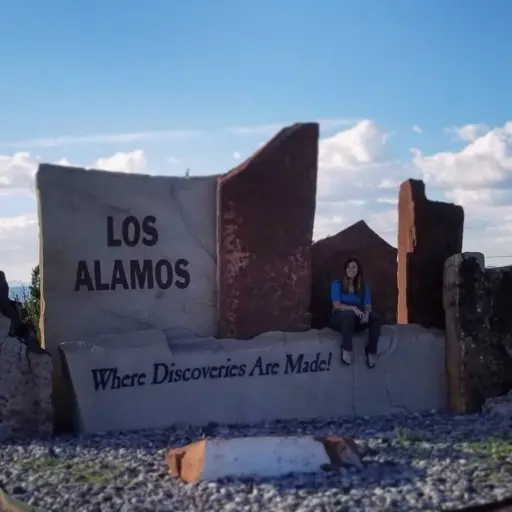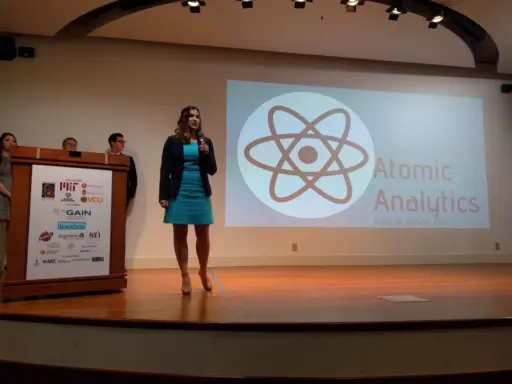In an age increasingly defined and connected by online discourse, UW-Madison graduate student Katie Mummah is taking full advantage of the digital tools at her disposal—all in the name of science.
Mummah, an nuclear engineering and engineering physics PhD student, is known as “Nuclear Katie” (@nuclearkatie) online, where she’s leveraged her passion for nuclear science into a social media presence that is at once brimming with enthusiasm for science and nuclear energy and teeming with factual information.
Mummah’s goal? To inject the online debate surrounding nuclear technology with some fact-based optimism. Her approach? Frequent info-laden posts supplemented by a healthy dose of the internet’s lingua franca: memes, GIFs and retweets. Her online charisma has to-date netted Mummah more than 3,000 followers on Twitter. And while she enjoys engaging in the social media banter, what Mummah really wants is to open minds.
 Mummah has spent the last two summers conducting research at the Los Alamos National Laboratory in New Mexico.
Mummah has spent the last two summers conducting research at the Los Alamos National Laboratory in New Mexico.
“As a nuclear scientist, I see myself as an advocate for nuclear energy,” Mummah explains.
That can be a tricky prospect online, where advocacy can easily be drowned out or even backfire. So Mummah has learned to pick her battles and to shun emotional pleas in favor of sober analysis. “There’s a pretty healthy anti-nuclear community on Twitter,” Mummah says. “But the only time I choose to engage with that community directly is if I think that my half of a discussion will provide insight for other people reading the thread.”
Implicit in that strategy is the understanding that Mummah and her like-minded peers likely aren’t going to change the minds of people who already solidly oppose nuclear energy. Instead, Mummah wagers that she can wield facts to provide a credible counterpoint to naysayers. And she counts on her personality and her respectful, positive tone to starve the trolls, who tend to feed on emotional pleas and negativity.
“My approach to social media is all about balance,” Mummah says. “There are nuclear scientists who only present facts and are very dry. Then there are really emotional people. I try to sit in between, where I’m sharing my enthusiasm for nuclear energy with facts, and in a way that I think is interesting and provides a lot of context. I like to answer questions and to be respectful when I’m making a point.”
The final ingredient in Mummah’s social media success is the sheer profusion of her enthusiasm for nuclear science in the form of nonstop activity. Her prolificacy is a constant whether she’s preparing for qualifying exams or working on her research, in which she models the nuclear fuel cycle from mine to repository. Mummah hopes the computer models she’s developing will make it more efficient for the International Atomic Energy Agency (IAEA) to keep track of nuclear materials in the future. That’s a must if nuclear energy is to become more widely available worldwide, which Mummah contends is itself a must if the world is serious about moving away from fossil fuel-derived energy.
 Mummah participated in Nuclear Bootcamp, where she and a team pitched venture capitalists in San Francisco on a nuclear energy-related business plan.
Mummah participated in Nuclear Bootcamp, where she and a team pitched venture capitalists in San Francisco on a nuclear energy-related business plan.
“At the end of the day, we’re going to need a diversity of energy sources going forward,” Mummah says. “Wind, solar and nuclear fit different needs, and nuclear will be necessary for as a baseload source. At the same time, we’ll need the wall between nuclear energy and nuclear weapons to be as strong as possible if we want nuclear energy to expand.”
Mummah believes her high-power computational models, which draw on complex physics models and systems models, will help the international community keep nuclear materials safe throughout their lifecycle.
The federal government’s national laboratory system also sees promise in Mummah’s efforts. In 2018, Mummah spent her second summer conducting research at Los Alamos National Laboratory in New Mexico, where she was funded by a Glenn T. Seaborg Institute summer fellowship to continue developing her models. The fellowship was funded through the Los Alamos and Lawrence Livermore National Labs as a part of the National Security Education Center (NSEC).
“Basically, this summer I wanted to see if the models I’ve been working on at Wisconsin could be integrated with tools that’ll go to the IAEA,” she says. “I wanted to know: Can these models be of benefit? Is this something that’ll be useful. The verdict is ‘yes.’”